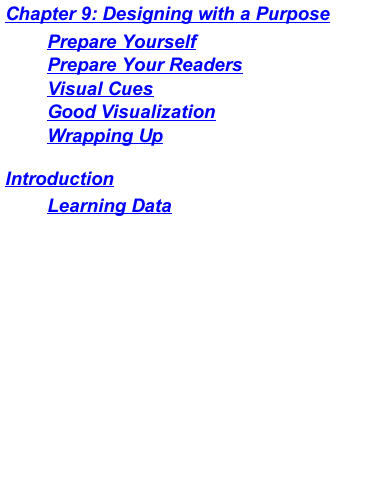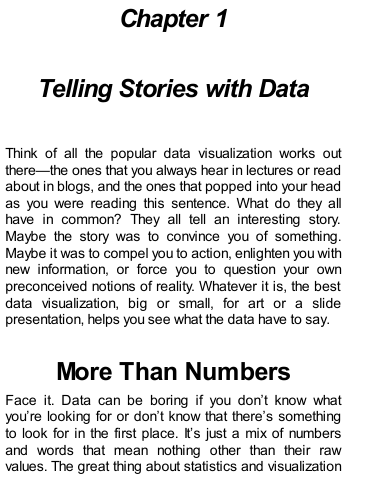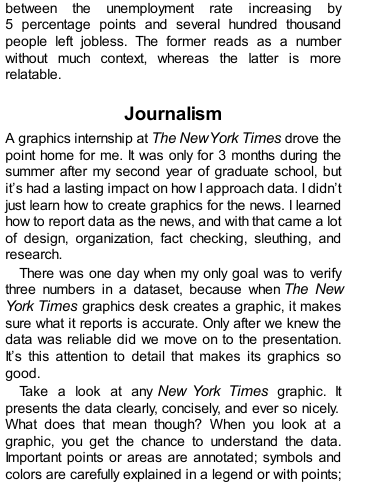�
Table of Contents
Cover
Chapter 1: Telling Stories with Data
More Than Numbers
What to Look For
Design
Wrapping Up
Chapter 2: Handling Data
Gather Data
Formatting Data
Wrapping Up
Chapter 3: Choosing Tools to Visualize
Data
Out-of-the-Box Visualization
Programming
Illustration
Mapping
Survey Your Options
Wrapping Up
Chapter 4: Visualizing Patterns over
Time
What to Look for over Time
Discrete Points in Time
Continuous Data
Wrapping Up
Chapter 5: Visualizing Proportions
What to Look for in Proportions
Parts of a Whole
Proportions over Time
Wrapping Up
Chapter 6: Visualizing Relationships
What Relationships to Look For
�
Correlation
Distribution
Comparison
Wrapping Up
Chapter 7: Spotting Differences
What to Look For
Comparing across Multiple
Variables
Reducing Dimensions
Searching for Outliers
Wrapping Up
Chapter 8: Visualizing Spatial
Relationships
What to Look For
Specific Locations
Regions
Over Space and Time
Wrapping Up
�
Chapter 9: Designing with a Purpose
Prepare Yourself
Prepare Your Readers
Visual Cues
Good Visualization
Wrapping Up
Introduction
Learning Data
�
Chapter 1
Telling Stories with Data
Think of all the popular data visualization works out
there—the ones that you always hear in lectures or read
about in blogs, and the ones that popped into your head
as you were reading this sentence. What do they all
have in common? They all tell an interesting story.
Maybe the story was to convince you of something.
Maybe it was to compel you to action, enlighten you with
new information, or force you to question your own
preconceived notions of reality. Whatever it is, the best
data visualization, big or small, for art or a slide
presentation, helps you see what the data have to say.
More Than Numbers
Face it. Data can be boring if you don’t know what
you’re looking for or don’t know that there’s something
to look for in the first place. It’s just a mix of numbers
and words that mean nothing other than their raw
values. The great thing about statistics and visualization
�
is that they help you look beyond that. Remember, data
is a representation of real life. It’s not just a bucket of
numbers. There are stories in that bucket. There’s
meaning, truth, and beauty. And just like real life,
sometimes the stories are simple and straightforward;
and other times they’re complex and roundabout. Some
stories belong in a textbook. Others come in novel form.
It’s up to you, the statistician, programmer, designer, or
data scientist to decide how to tell the story.
This was one of the first things I learned as a
statistics graduate student. I have to admit that before
entering the program, I thought of statistics as pure
analysis, and I thought of data as the output of a
mechanical process. This is actually the case a lot of
the time. I mean, I did major in electrical engineering, so
it’s not all that surprising I saw data in that light.
Don’t get me wrong. That’s not necessarily a bad
thing, but what I’ve learned over the years is that data,
while objective, often has a human dimension to it.
For example, look at unemployment again. It’s easy
to spout state averages, but as you’ve seen, it can vary
a lot within the state. It can vary a lot by neighborhood.
Probably someone you know lost a job over the past
few years, and as the saying goes, they’re not just
another statistic,
represent
individuals, so you should approach the data in that
way. You don’t have to tell every individual’s story.
However, there’s a subtle yet important difference
right? The numbers
�
the unemployment
between
increasing by
5 percentage points and several hundred thousand
people left jobless. The former reads as a number
without much context, whereas the latter is more
relatable.
rate
Journalism
A graphics internship at The New York Times drove the
point home for me. It was only for 3 months during the
summer after my second year of graduate school, but
it’s had a lasting impact on how I approach data. I didn’t
just learn how to create graphics for the news. I learned
how to report data as the news, and with that came a lot
of design, organization, fact checking, sleuthing, and
research.
There was one day when my only goal was to verify
three numbers in a dataset, because when The New
York Times graphics desk creates a graphic, it makes
sure what it reports is accurate. Only after we knew the
data was reliable did we move on to the presentation.
It’s this attention to detail that makes its graphics so
good.
Take a look at any New York Times graphic. It
presents the data clearly, concisely, and ever so nicely.
What does that mean though? When you look at a
graphic, you get the chance to understand the data.
Important points or areas are annotated; symbols and
colors are carefully explained in a legend or with points;
�
















 2023年江西萍乡中考道德与法治真题及答案.doc
2023年江西萍乡中考道德与法治真题及答案.doc 2012年重庆南川中考生物真题及答案.doc
2012年重庆南川中考生物真题及答案.doc 2013年江西师范大学地理学综合及文艺理论基础考研真题.doc
2013年江西师范大学地理学综合及文艺理论基础考研真题.doc 2020年四川甘孜小升初语文真题及答案I卷.doc
2020年四川甘孜小升初语文真题及答案I卷.doc 2020年注册岩土工程师专业基础考试真题及答案.doc
2020年注册岩土工程师专业基础考试真题及答案.doc 2023-2024学年福建省厦门市九年级上学期数学月考试题及答案.doc
2023-2024学年福建省厦门市九年级上学期数学月考试题及答案.doc 2021-2022学年辽宁省沈阳市大东区九年级上学期语文期末试题及答案.doc
2021-2022学年辽宁省沈阳市大东区九年级上学期语文期末试题及答案.doc 2022-2023学年北京东城区初三第一学期物理期末试卷及答案.doc
2022-2023学年北京东城区初三第一学期物理期末试卷及答案.doc 2018上半年江西教师资格初中地理学科知识与教学能力真题及答案.doc
2018上半年江西教师资格初中地理学科知识与教学能力真题及答案.doc 2012年河北国家公务员申论考试真题及答案-省级.doc
2012年河北国家公务员申论考试真题及答案-省级.doc 2020-2021学年江苏省扬州市江都区邵樊片九年级上学期数学第一次质量检测试题及答案.doc
2020-2021学年江苏省扬州市江都区邵樊片九年级上学期数学第一次质量检测试题及答案.doc 2022下半年黑龙江教师资格证中学综合素质真题及答案.doc
2022下半年黑龙江教师资格证中学综合素质真题及答案.doc